Driving in Gran Canaria - Our Experiences
Disclosure: The content on this page includes affiliate links. While clicking on these links won’t cost you anything extra, we may earn a modest commission from any purchases.
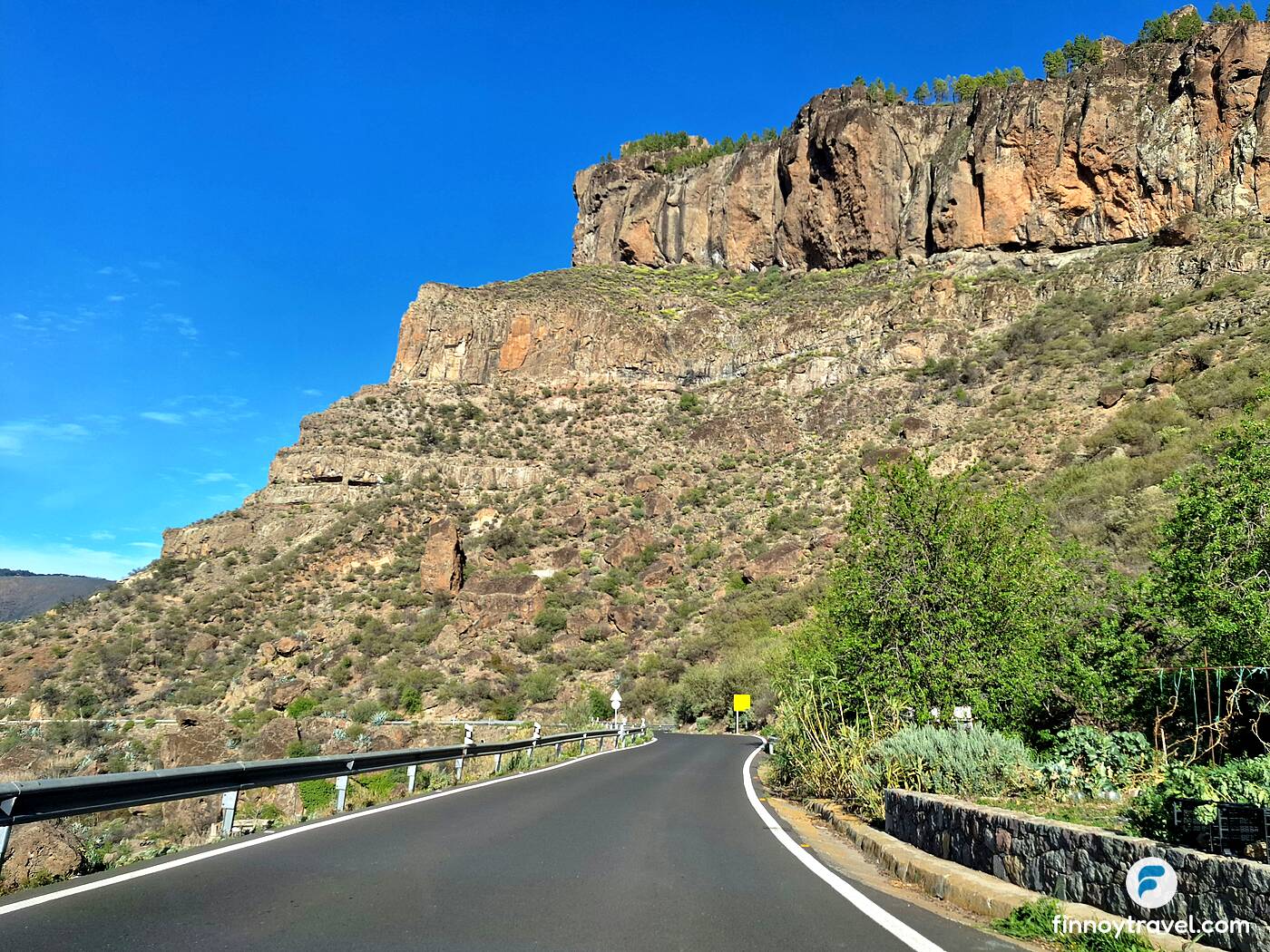
The lack of sunshine enticed us to leave the cold weather of Finland behind for a week-long getaway in Gran Canaria. We preferred to establish our base in the island's warm southern region, but we opted to rent a car for the flexibility to roam freely. In this article, we divulge the insights we gained about navigating the roads of Gran Canaria and offer helpful advice. Dive into the article to discover essential information you need to know about driving in Gran Canaria.
Covered in the Article
Trip to Gran Canaria - 7 Days of Driving
We were still waiting for the spring in Finland when we decided to take a one-week break in Gran Canaria. We had accumulated Norwegian's Cashpoints that were expiring soon, so we booked a flight from Helsinki to Gran Canaria with Norwegian Air. Since the return flight would have been quite expensive, we booked only one way and opted to fly back with Air France despite the layovers. The trip was a success, thanks to the delightful weather, which allowed us to explore Gran Canaria for seven consecutive days with a rental car.
We preferred having our base in the warmer and sunnier South of the island. After some research, we found that Marina Elite near Puerto Rico offered reasonable prices and had a convenient closed parking area for cars. As soon as we got our flights booked, we promptly booked the hotel and placed a booking for a week's car rental, and soon, we were all set for our trip.
Renting the Car
As usual, we searched for different options at Discover Cars, our favourite car rental comparison website, to find the perfect vehicle for our journey. Discover Cars displayed options from various rental companies in one search. After comparing prices and reading previous customer reviews, we rented a car from Orlando Rent a Car. The cost of a mini class car for one week was only 90 euros, which we found reasonable.
We noticed one drawback during the booking phase: Orlando Rent a Car did not have an office at the airport, but they offered a Meet & Greet service instead. Given the affordability, we chose to go with this option.
We like Discover Cars for its convenient comparison feature, but we hesitate to recommend Orlando Rent a Car due to the issues we encountered in Gran Canaria. Opting for a slightly more expensive option through Discover Cars might have ensured a better service experience.
Challenges with Orlando Rent a Car
Orlando Rent a Car failed to meet us at the airport at the pre-agreed time, and they did not initiate any contact with us.
Upon reaching out to them by a call, they assured us they would arrive soon, but it still took an additional 30 minutes. Once they arrived, they transported us, along with other car rental customers, to their office, where we encountered a lengthy queue that delayed us by an hour. The process was cumbersome and slow-paced. We have never experienced this slow car pickup.
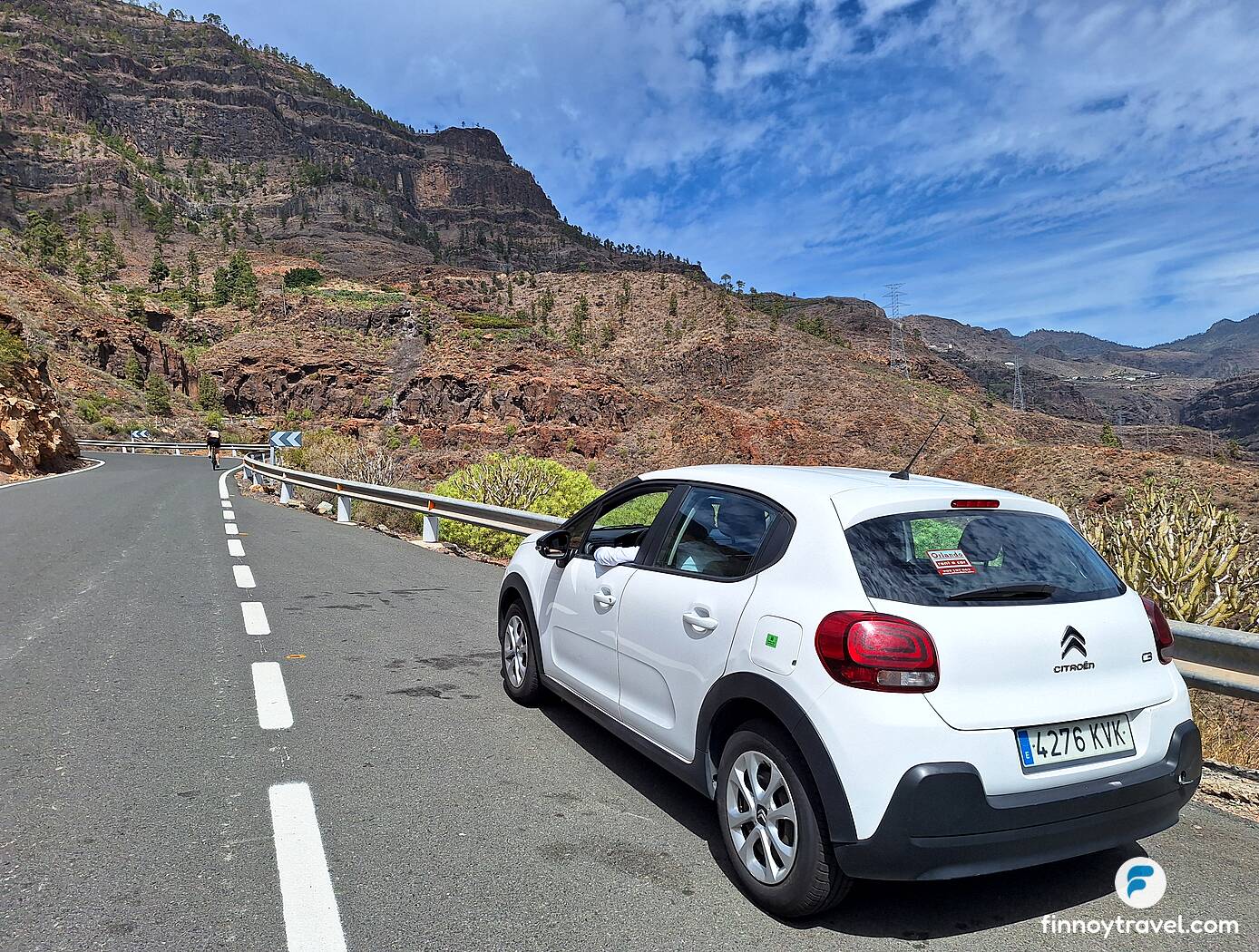
Eventually, two hours post-landing, we received our car, a Citroën. Interestingly, it was larger than we had initially booked, which was acceptable. However, the car had numerous scratches, necessitating considerable time to take photos and videos for documentation. The rental company did not provide an introduction or inspection of the car, but we managed without it. With the aid of Google Maps, we then proceeded to our hotel.
A few days later, the car's engine warning light illuminated. We contacted the rental company's office to report the issue, and a staff member acknowledged they were aware of it, explaining that it's a common occurrence with this particular car.
Upon returning the car, we were confident it was in the same condition as when we took it on the first rental day. However, the representative of the car rental company claimed there was a new scratch on the car. With detailed documentation of the car, we proposed that the car rental staff scrutinise the images alongside each scratch on the car to verify if any new ones had appeared. Upon hearing this, the representative confirmed that everything was in order without bothering to review the photos and videos we took before we drove this car.
Tips for More Successful Rental Experience
Discover Cars can be recommended as it efficiently aggregates information from numerous companies. It's crucial to read over the reviews by previous customers to gauge the quality of the selected rental company. Remember, the least expensive options may not always offer the best value. So our advice is not to settle for the cheapest option. Usually, the car may not be in excellent condition.
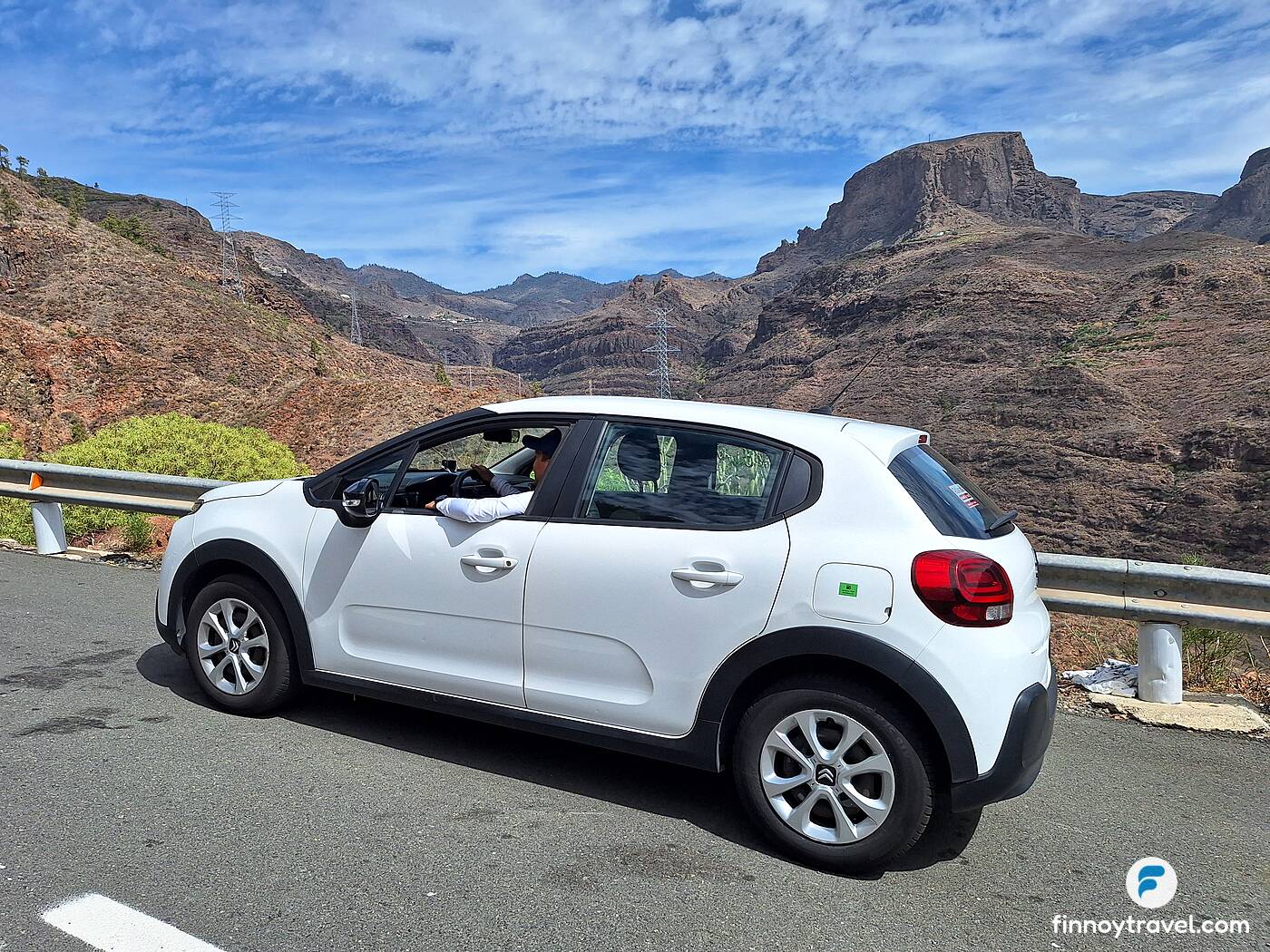
Discover Cars offers affordable complete protection to cover the car's insurance deductible. This operates in such a way that you pay the deposit directly to the car rental company, and in case of any incidents, they use this deposit to cover the excess charges. You can then request reimbursement from Discover Cars. Although this process may seem more complex than purchasing comprehensive insurance directly from the rental company, it can lead to significant savings for frequent car renters.
Take photos and videos of the car before driving to protect yourself. Documenting the car's condition with pictures and videos is for your protection in case of disputes. Regardless of your insurance, you are responsible for driving the rental car carefully.
Driving in Gran Canaria
We outline key points about driving in Gran Canaria, drawn from our experiences and research. For detailed traffic regulations, always consult official sources and ask for help from the rental company.
Licence
All drivers must have a valid driving licence to operate a vehicle in Gran Canaria. Licences issued by EU and UK authorities are accepted, eliminating the need for an international driving permit. Should your licence be issued by a country outside of the EU and UK, and you're unsure about its validity in Gran Canaria, it's recommended to check with an authoritative source for confirmation.
Rental companies might decline to rent a car to individuals with a licence for less than a year. Additionally, both young and elderly drivers may be subject to an extra fee. Fortunately, it is simple to review the rental terms on Discover Cars before finalising the booking.
Right-sided Traffic, Priority and Traffic Signs
In Gran Canaria, driving is on the right side of the road, and you must give way to vehicles approaching from the right.
When encountering a triangle or STOP sign, giving way to all other traffic is mandatory. Pedestrians at zebra crossings always have the right of way.
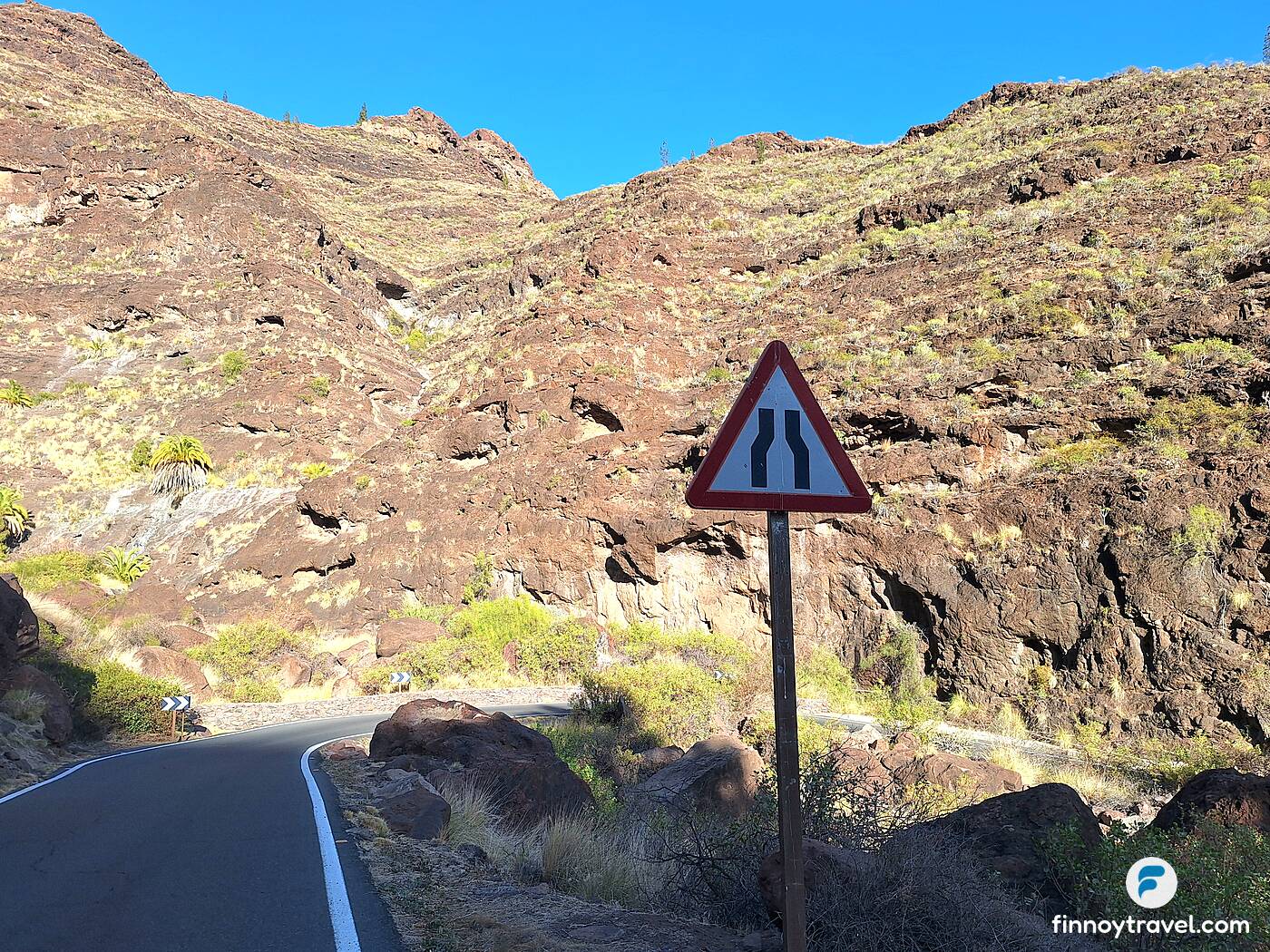
Show courtesy to fellow travellers in busy tourist areas by allowing them plenty of space to cross streets safely.
Municipal Roads
The roads in tourist areas are relatively easy to navigate, with minimal traffic and a generally slow pace.
The situation changes as you head towards the mountains, small villages, or Las Palmas. Streets in small towns can be exceedingly narrow with steep inclines, necessitating very cautious driving. Traffic near Las Palmas can be hectic and might challenge inexperienced drivers. However, those accustomed to driving in other major European cities should be able to manage in Las Palmas as well.
We visited Las Palmas twice with the rental car. Parking was the major challenge.
Motorway and Superhighways
Gran Canaria features one motorway: GC1 links the airport to Maspalomas, Puerto Rico, and Mogan. There are also three superhighways called GC2, GC3 and GC4. They are similar to the motorway.
The motorway and superhighways expand to two or three lanes in each direction, with speed limits ranging from 80 km/h to 120 km/h. Despite the heavy traffic, the flow remains smooth, making it a pleasant driving experience.

Remember to turn the lights on in tunnels or when it's dark.
Mountain Roads
When you leave from the coastline, you will soon encounter mountain roads. Some of these roads feature smooth surfaces, ample width, and protective fences, making them easy to drive on as long as you maintain a low speed.
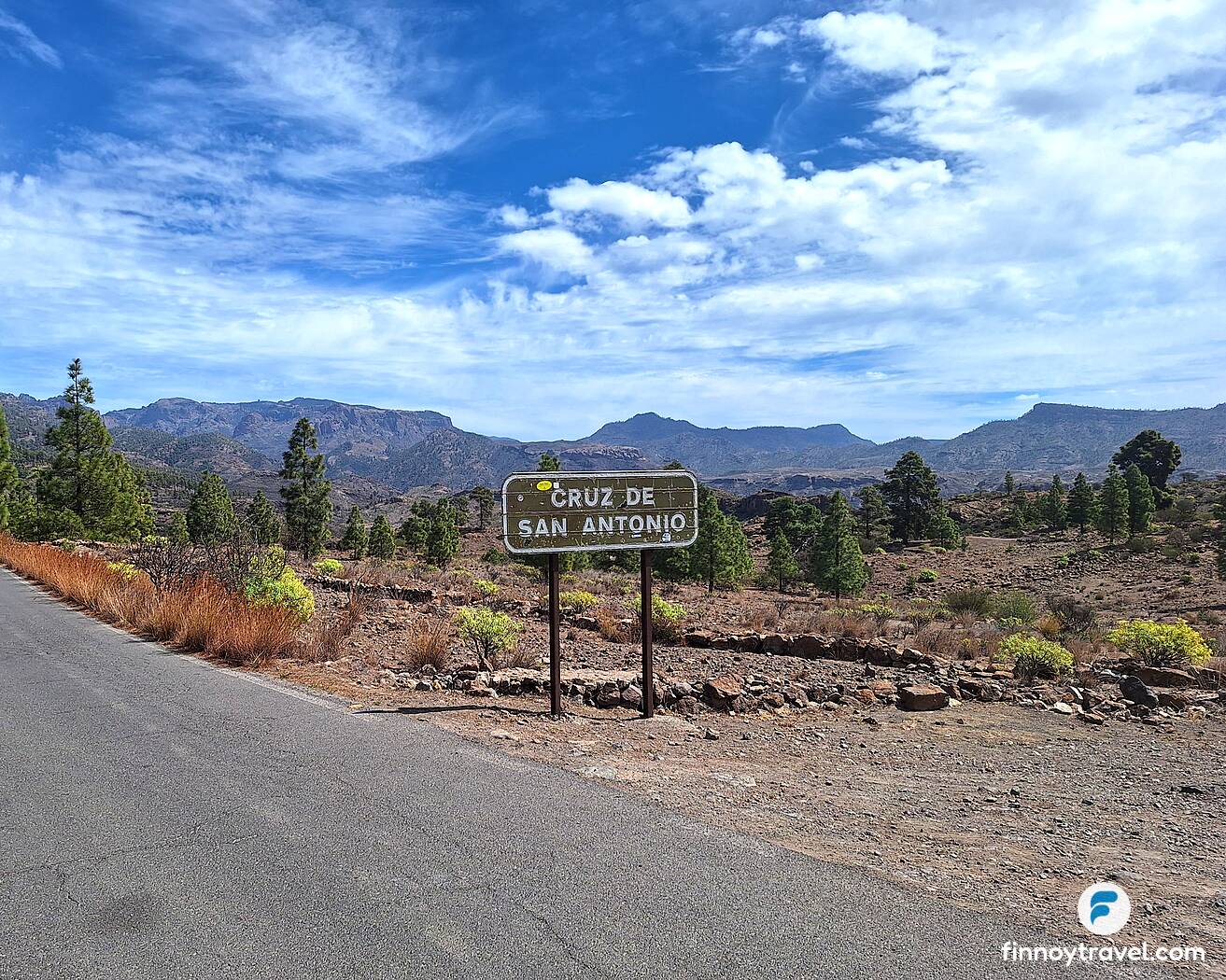
However, if you rely on navigation apps like Google Maps, as we did, you might find yourself on extremely narrow and steep roads with poor surfaces. Despite the minimal traffic, these roads can pose a driving challenge, requiring proficient clutch handling skills if you drive with a manual transmission. Nevertheless, if you maintain a low speed, these roads are manageable but stressful.
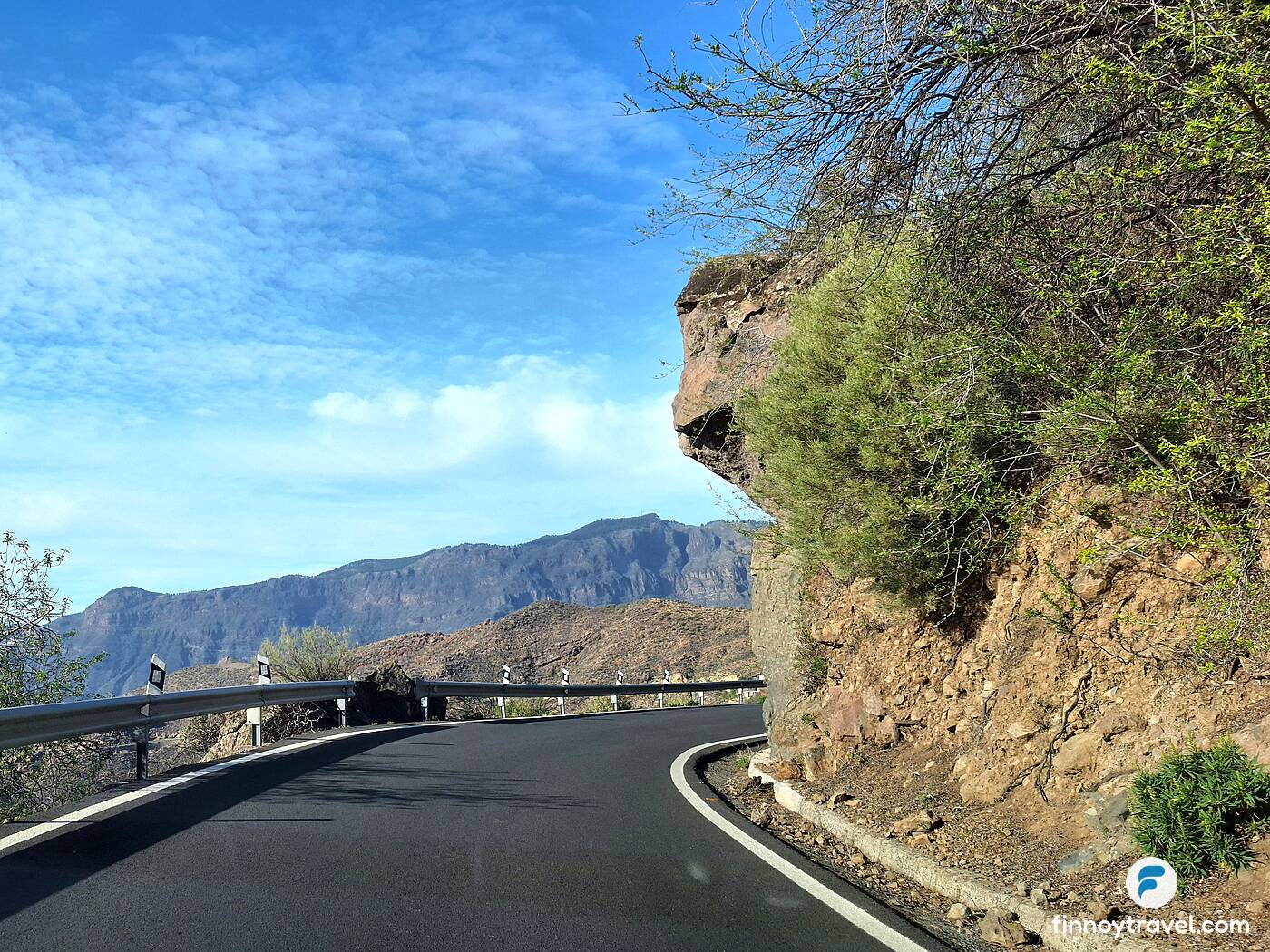
For inexperienced mountain drivers, it's important to remember to use engine braking when descending. This helps prevent your brakes from overheating.
Speed Limits
The speed limit on motorways is 120 km/h. Within urban areas, the speed limit is set to 50 km/h unless otherwise indicated. Beyond these areas, the default limit increases to 90 km/h or 100 km/h, depending on the road type. However, be aware that specific limits can be indicated by traffic signs, and speed cameras are in operation to enforce these limits.
Obey speed limit signs for your safety. Especially on mountain roads, driving fast is unsafe.
Parking
Parking in Gran Canaria is straightforward.
We suggest selecting a hotel that offers free, secure parking to alleviate the worry of finding a parking spot at night.
In tourist areas, free street parking may be denoted by white zones. While parking there is free, it's important to observe any limits indicated by traffic signs. Metered parking areas are highlighted with blue zones, where a ticket must be bought from a machine or parking app. Tourist regions, Las Palmas, and smaller towns are equipped with numerous parking garages, where you can park, collect a ticket, and pay the fee before exiting. This method is highly convenient for parking in busier locales.
Here's a summary of the different parking zone colours in Gran Canaria with their restrictions:
- White Zones: Often free parking, but always check for local signs that might indicate time limits or other restrictions.
- Green Zones: Resident parking only. Non-residents will likely be fined or towed.
- Blue Zones: Paid parking. You must purchase and display a ticket from a machine.
- Yellow Zones: No parking. These are for entrances/exits or other restricted areas.
Tip: Always pay close attention to the colour of the lines or curbs and check for any posted signs with specific parking rules before leaving your vehicle.
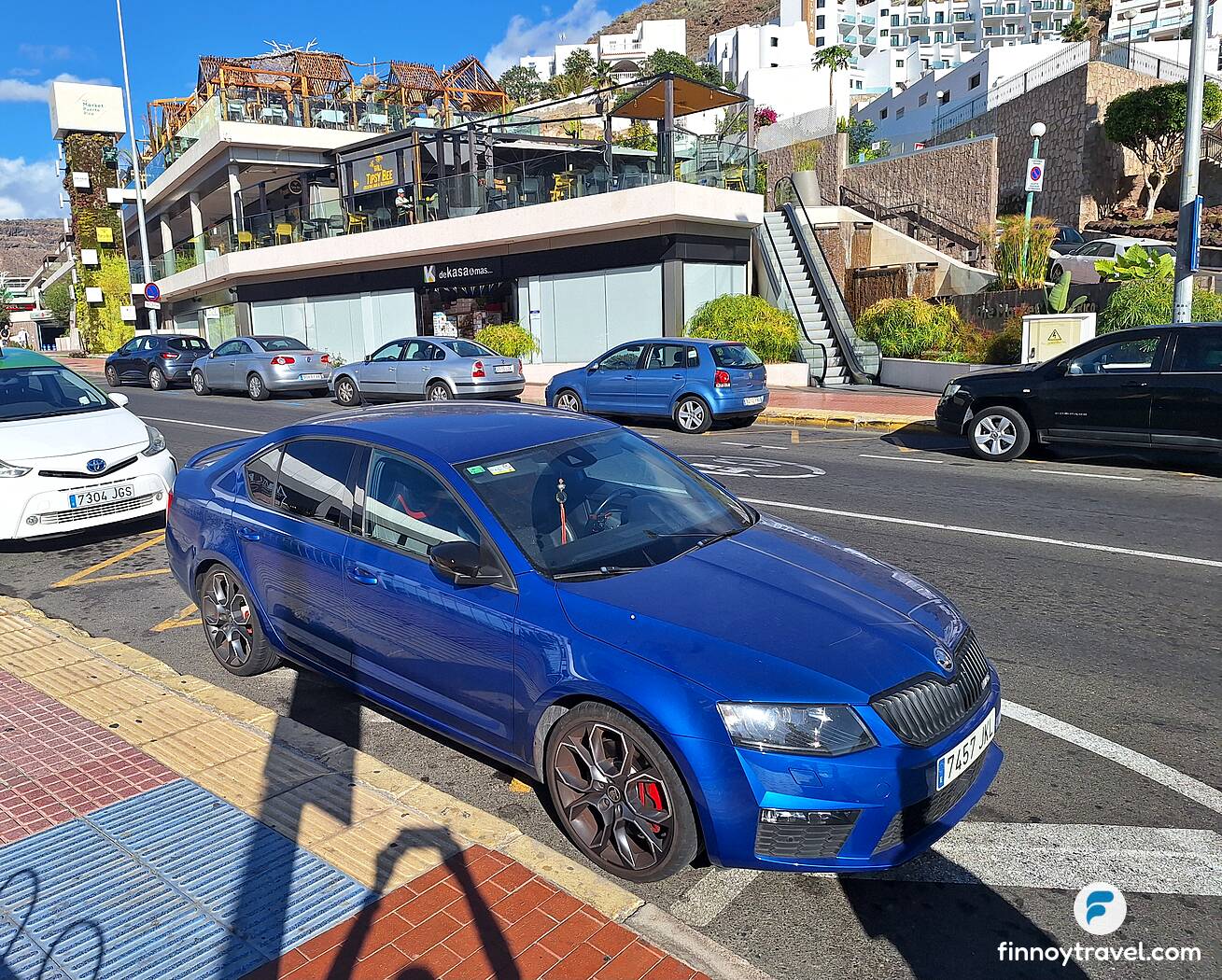
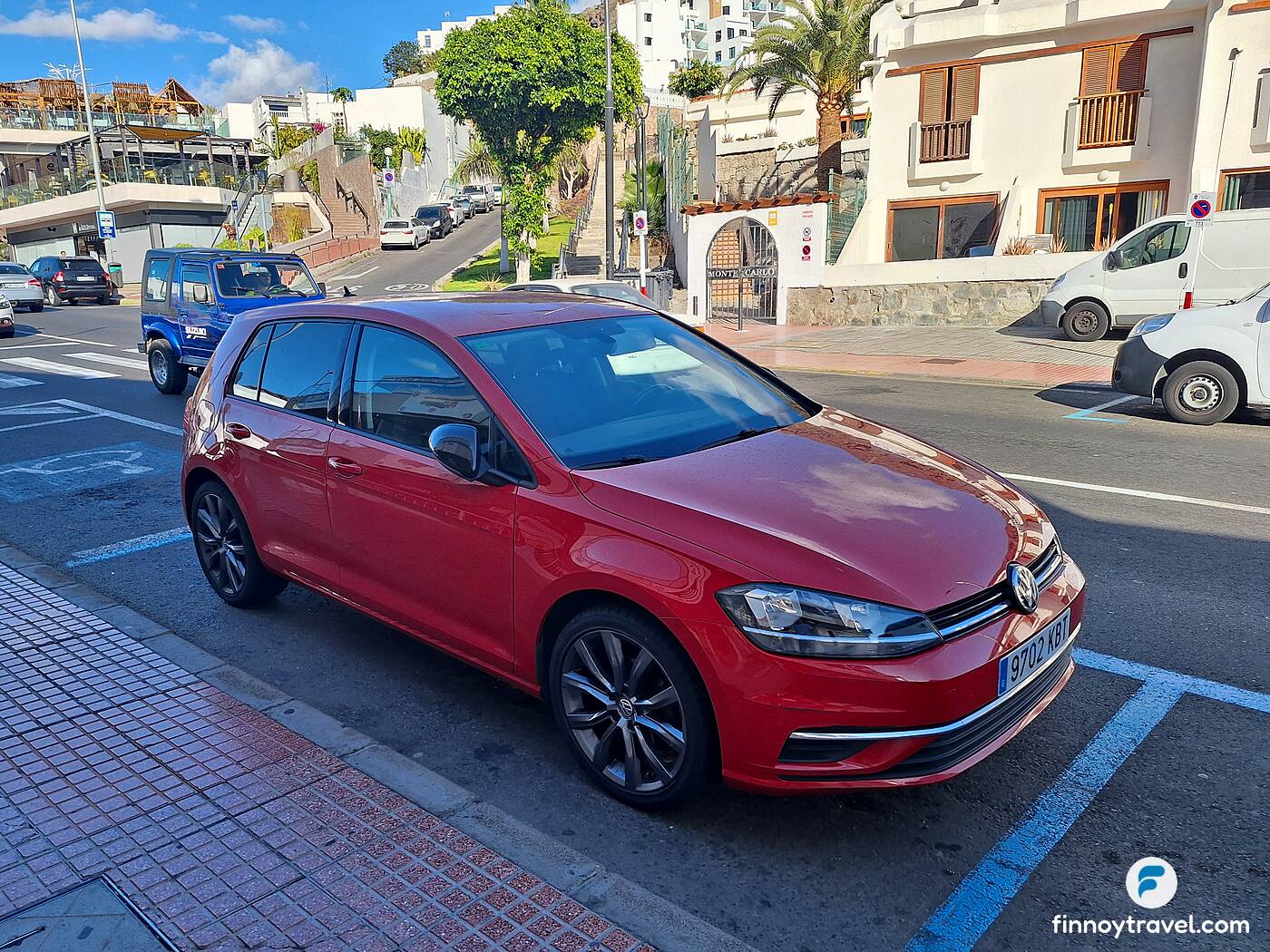
The majority of parking halls accept a card payment.

It is easy to get cars scratched while parking, so we recommend buying full protection from Discover Cars.
Refueling
Fuel in Gran Canaria is inexpensive.
For the most budget-friendly option, consider self-service gas stations like PetroPix. These stations typically offer lower prices because you pump the gas yourself and pay at the pump with a credit or debit card. Expect to pay around 1.10 euros per litre for E95 gasoline.
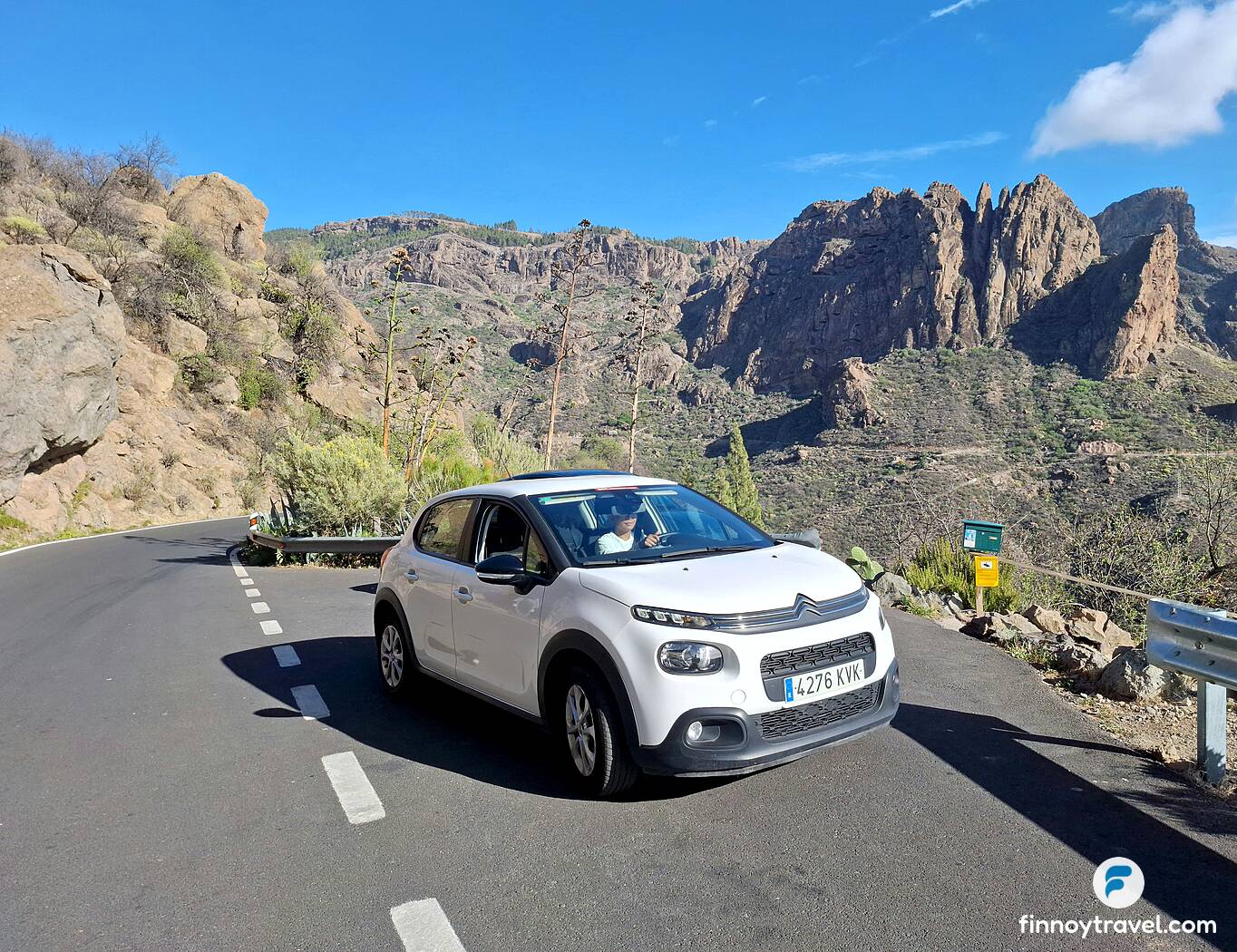
Always pay attention to filling the tank with the right fuel type.
Cyclists
One crucial point that cannot be emphasised sufficiently is the high presence of cyclists on the island, particularly on mountain roads from early morning to late afternoon.
You must ensure they have ample space to cycle safely. Consider that they might descend swiftly, and your visibility behind curves may be limited. Always anticipate encountering a cyclist or another vehicle when navigating mountainous terrain. Minimising risk is crucial to ensuring the safety of all road users.
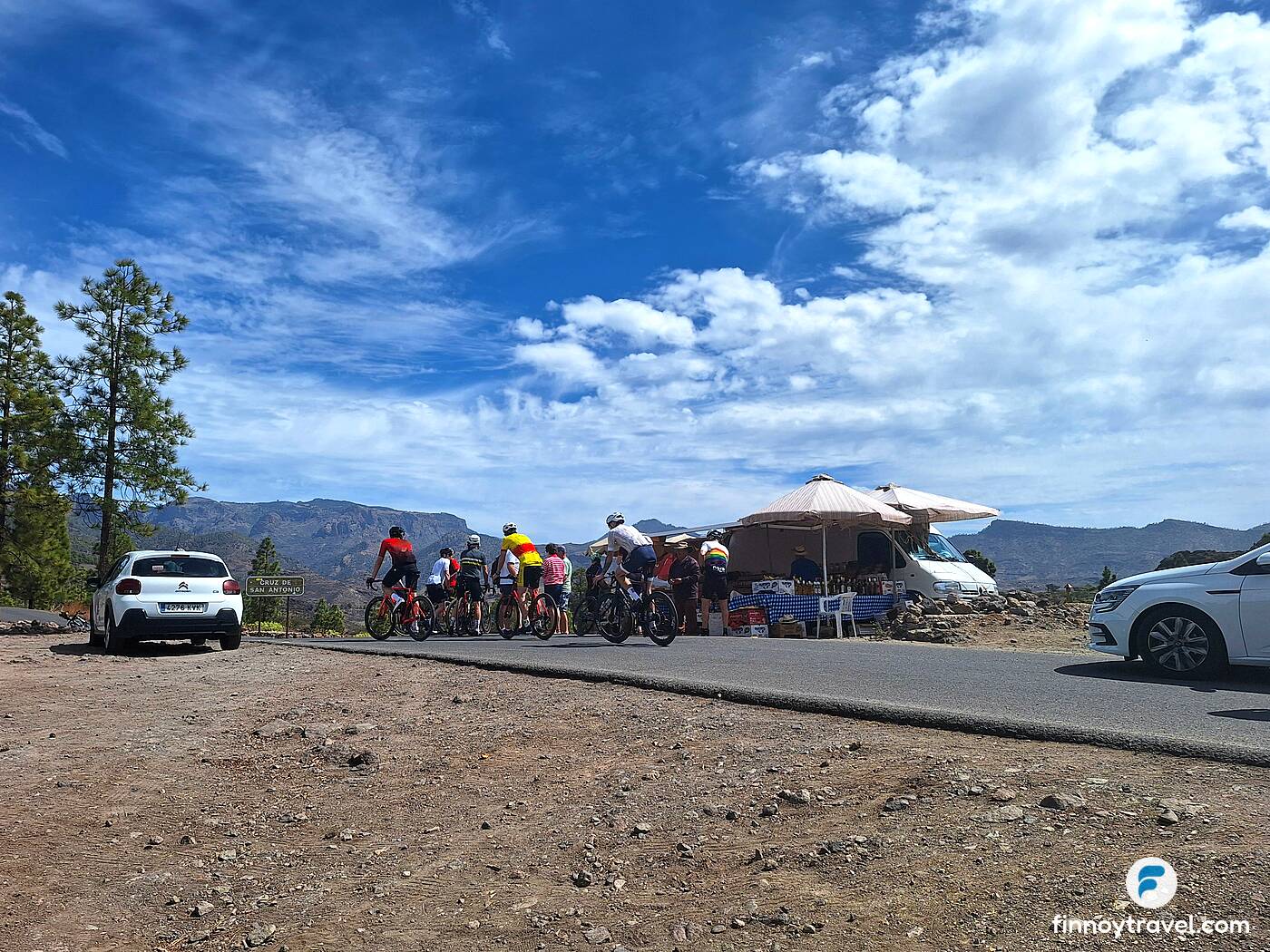
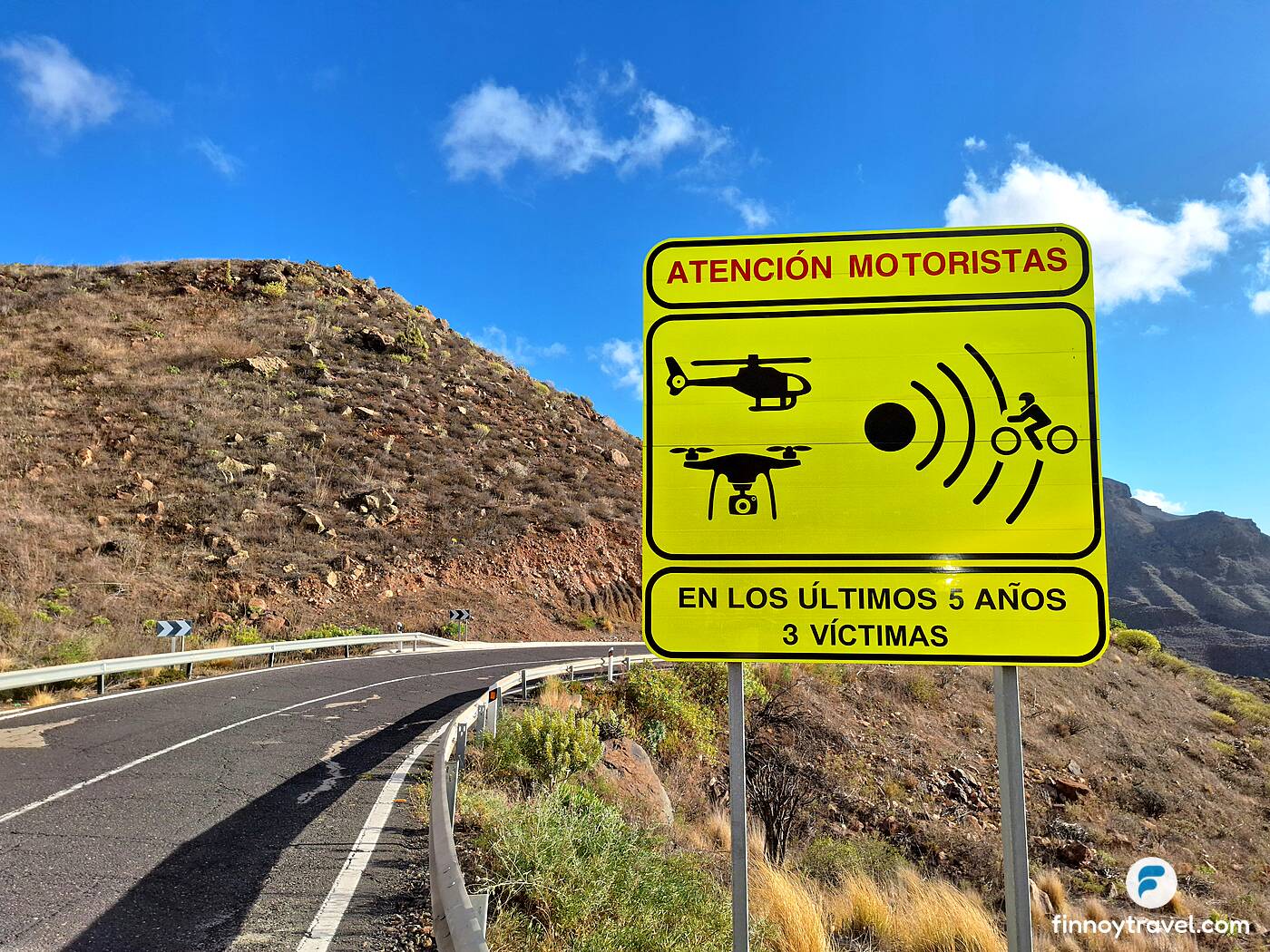
Buses on Mountains
While we encountered only a few public buses in the mountains, there is a notable presence of tourist buses. Due to their size and limited manoeuvrability, private cars must yield to them when encountering them on mountain roads. Our recommendation remains the same: approach curves cautiously and be ready to halt or reverse if necessary to accommodate buses. Fortunately, bus drivers on the island are accustomed to tourist drivers and exercise caution while driving.
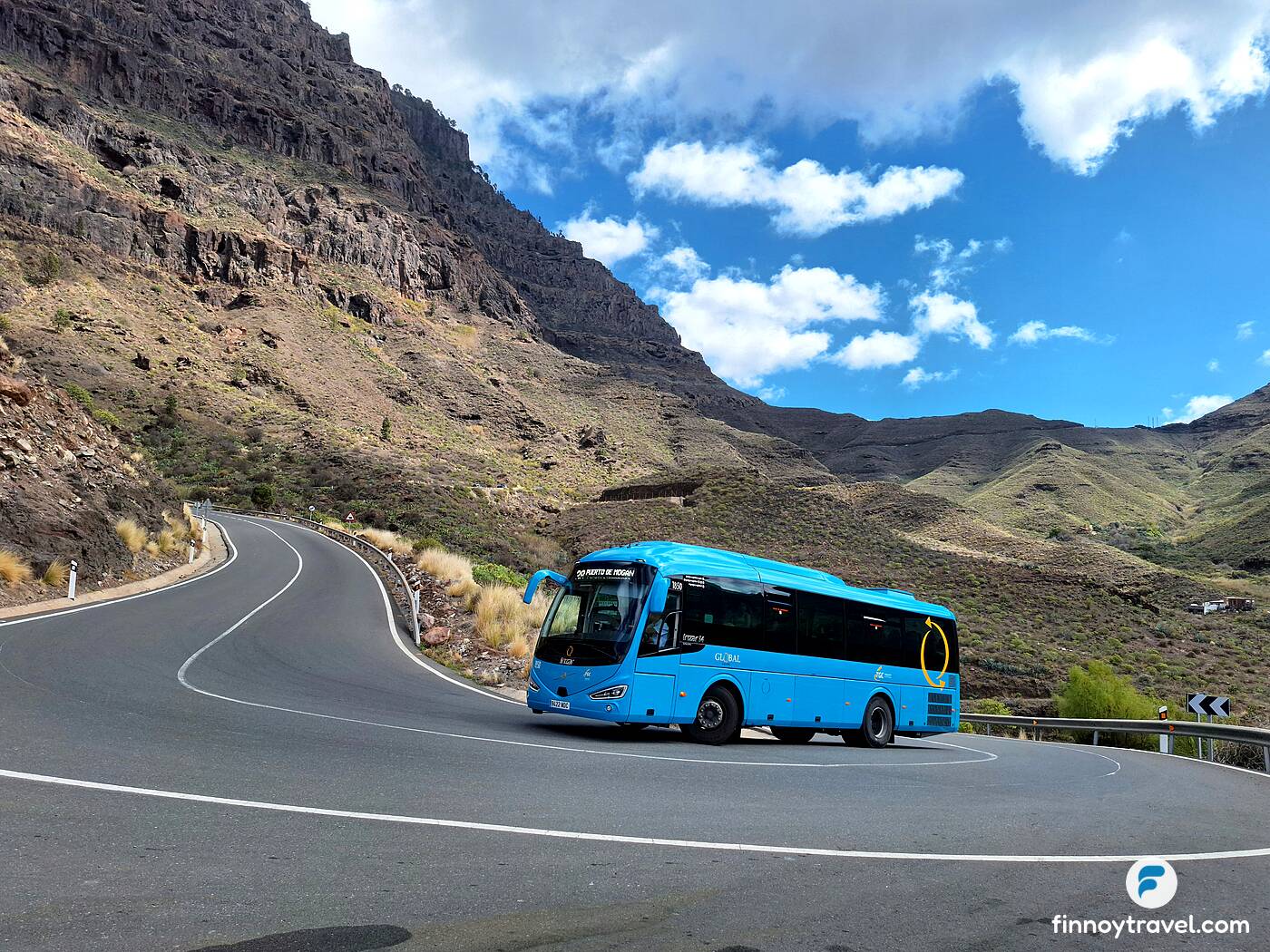
We give four suggestions for where we recommend you drive with your rental car. These spots were our favourites.
Caldera de Bandama
Caldera de Bandama, situated near Las Palmas, stands out as an impressive volcanic landmark characterised by breathtaking panoramic views. This extraordinary natural marvel attracts hikers and nature lovers alike, eager to delve into its distinct geological structures and varied plant life. There is also a small mountain with a nice viewpoint and a sightseeing restaurant.
To arrive at Caldera de Bandama from the South of the island, begin your journey on the GC-1 motorway heading towards Las Palmas. Proceed to merge onto the GC-3 highway and look for the signs directing you to the GC-802; this road will take you straight to the location. There are free parking spaces.
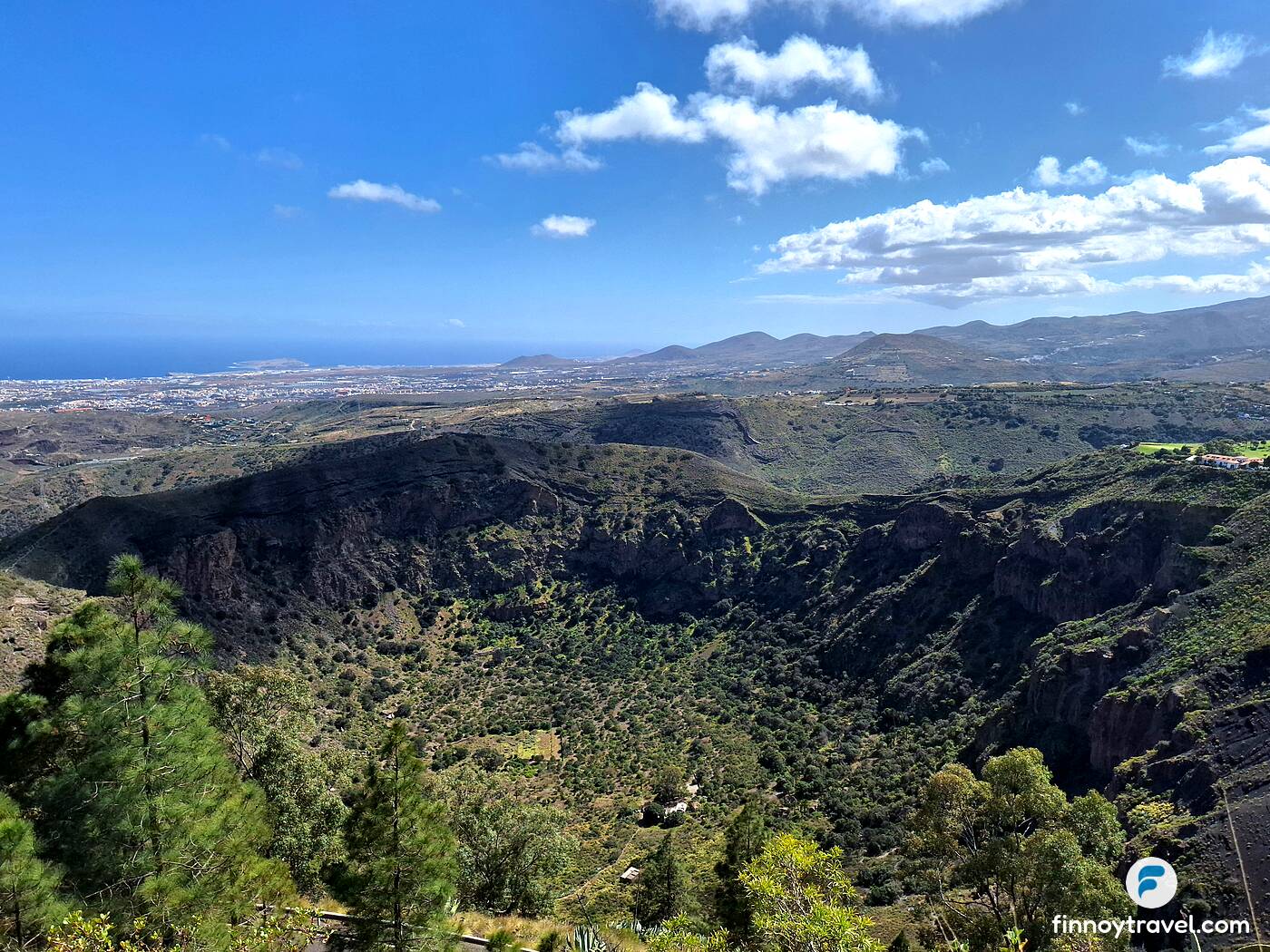
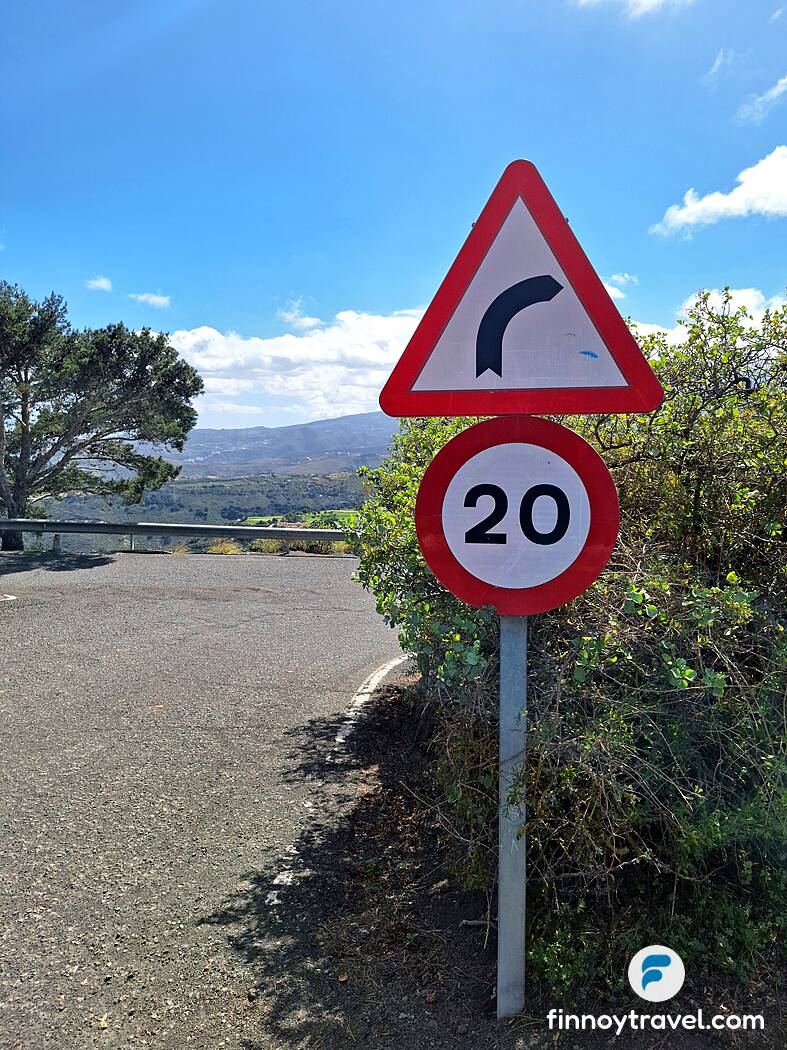
Pico de las Nieves
Pico de las Nieves stands as Gran Canaria's tallest peak, captivating visitors with its stunning panoramic views, making it a favourite spot among residents and travellers. The summit reaches an impressive height of 1,949 meters above sea level, offering a spectacular viewpoint that overlooks the island and the vast Atlantic Ocean. You can see even the Teide volcano in Tenerife.
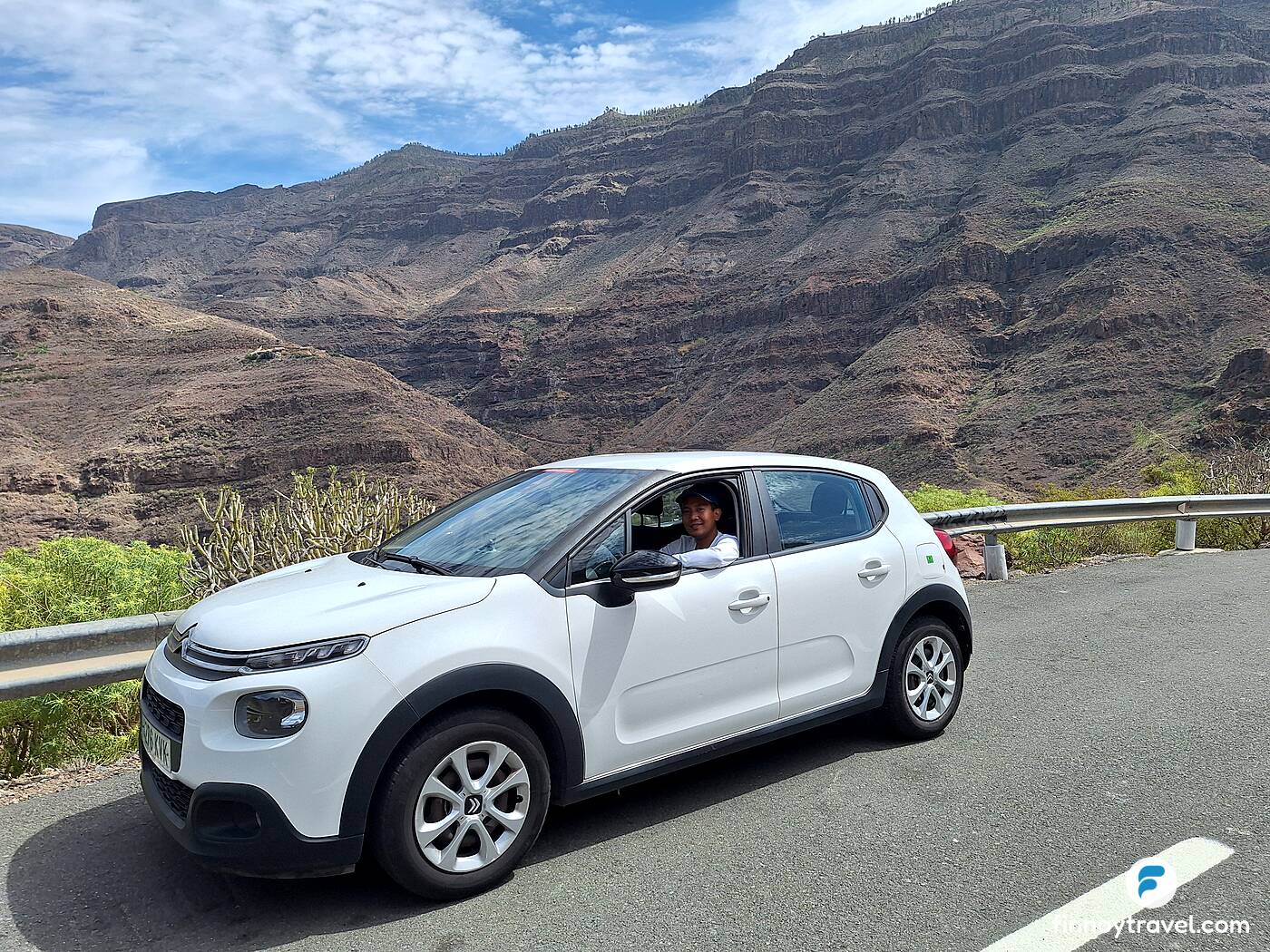
To journey to Pico de las Nieves from the island's South, start on the GC-1 motorway heading towards Las Palmas. Use Google Maps to find the route to the mountains leading to your destination. These roads can be narrow and winding, so driving cautiously is essential, especially in the presence of cyclists.
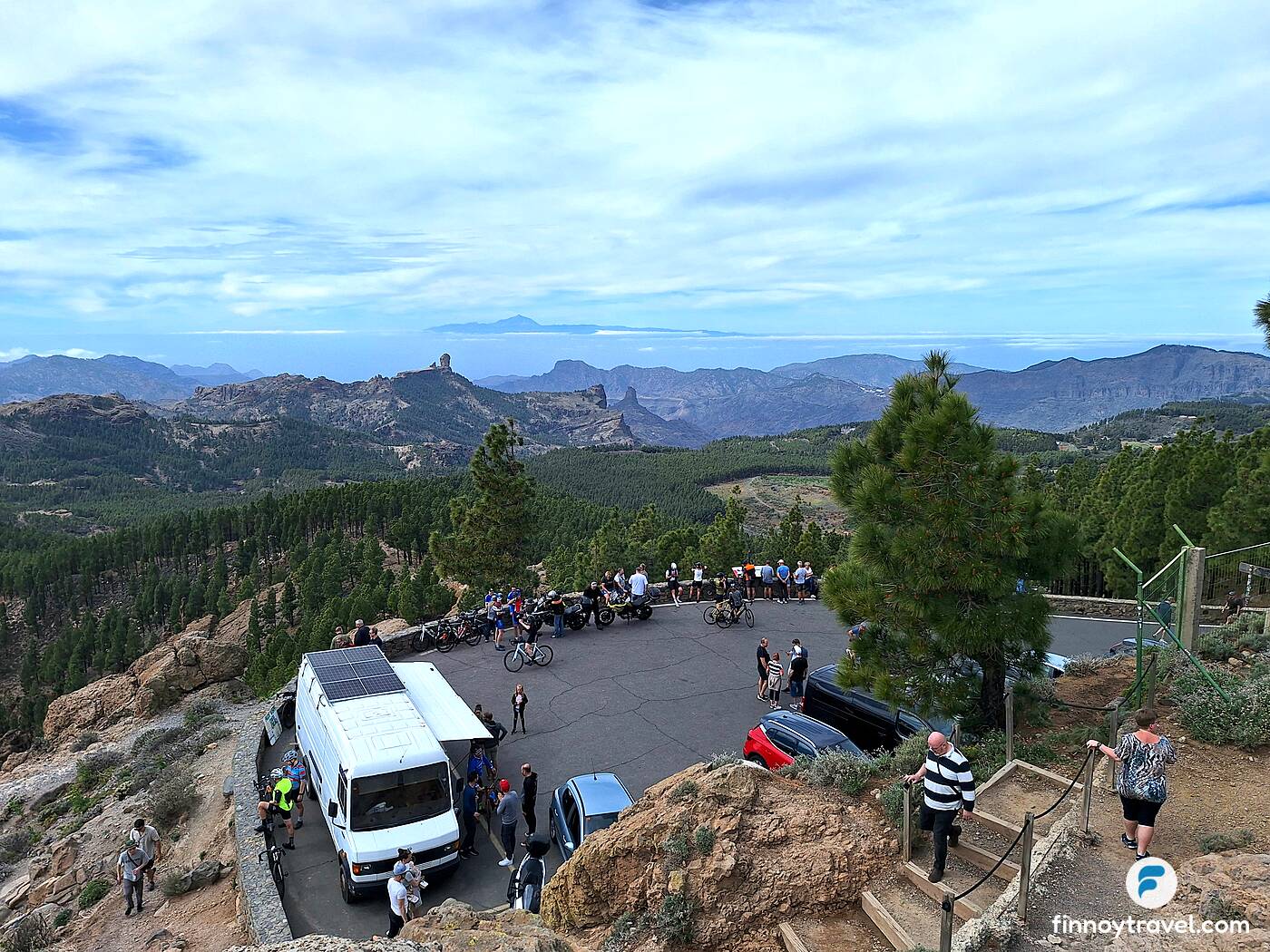
Teror
Teror is a captivating town located in the north of Gran Canaria. Its rich historical and cultural heritage distinguishes it. It is famed for its exquisite architecture. Its quaint cobblestone streets, traditional houses adorned with distinctive wooden balconies, and lively markets brimming with local delicacies establish Teror as an essential visit. We enjoyed a delicious lunch in Restaurante El Encuentro de Teror with excellent service.
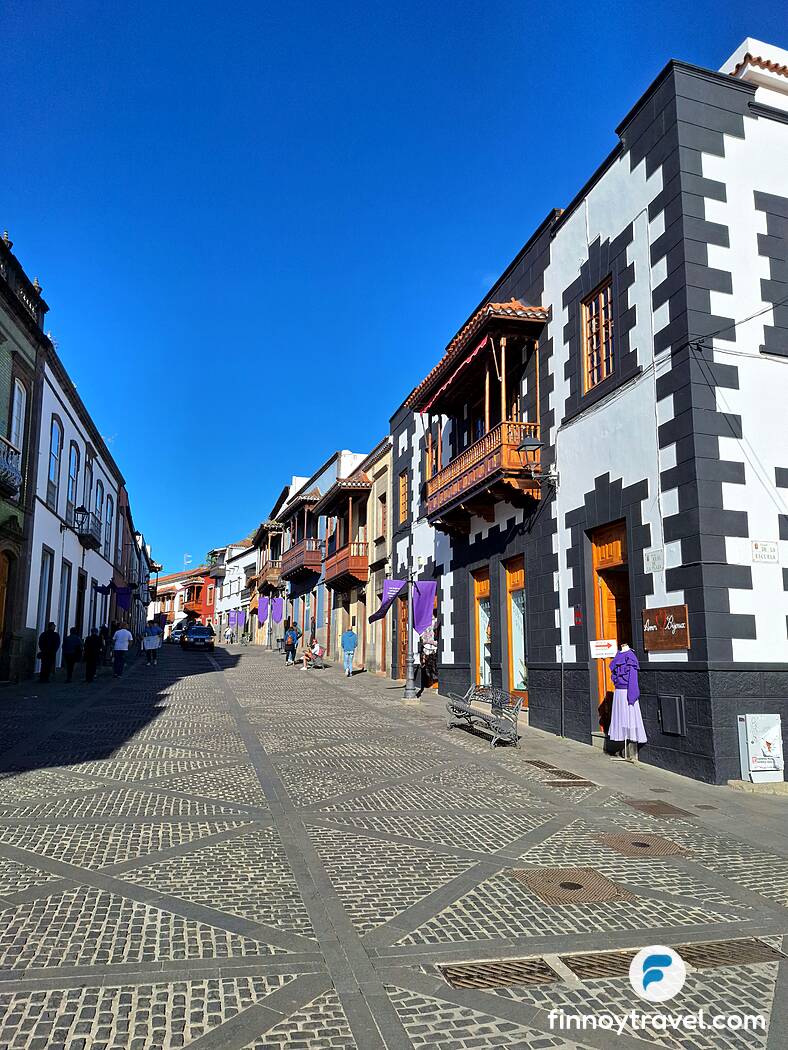
To get to Teror from the island's South, one embarks on a picturesque journey through the heart of Gran Canaria. Begin on the GC-1 motorway heading towards Las Palmas, then exit onto the GC-3 highway. Continue on the GC-3 until you join the GC-21 road directed towards Teror. Following the GC-21 will bring you straight into Teror's centre. This route, offering splendid views of the island's landscapes, usually takes an hour, although traffic can vary. Be prepared for narrower roads as you approach your destination, adding some adventure to your journey's final stretch. Remember to reserve enough time to drive back to the hotel before sunset.
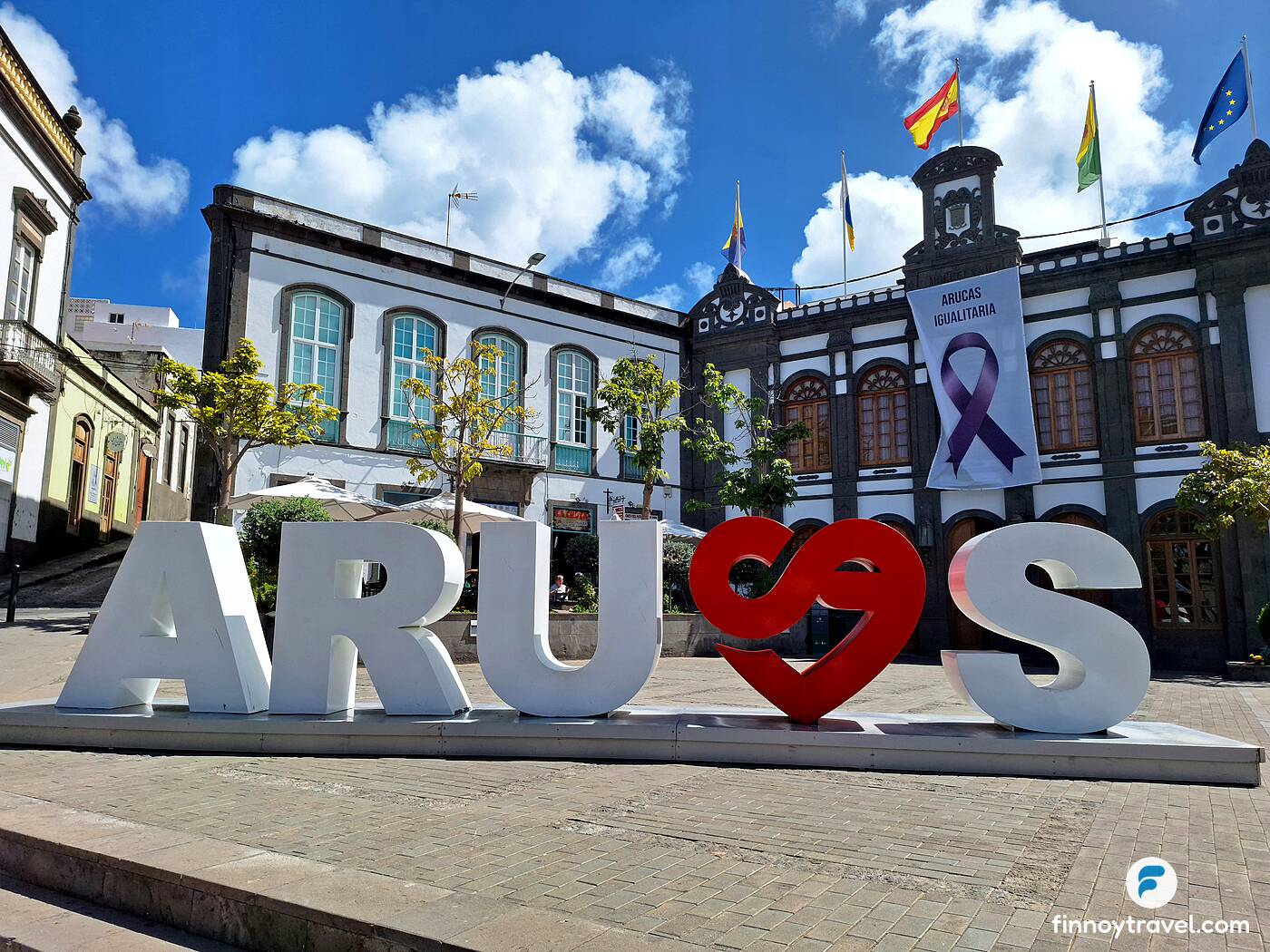
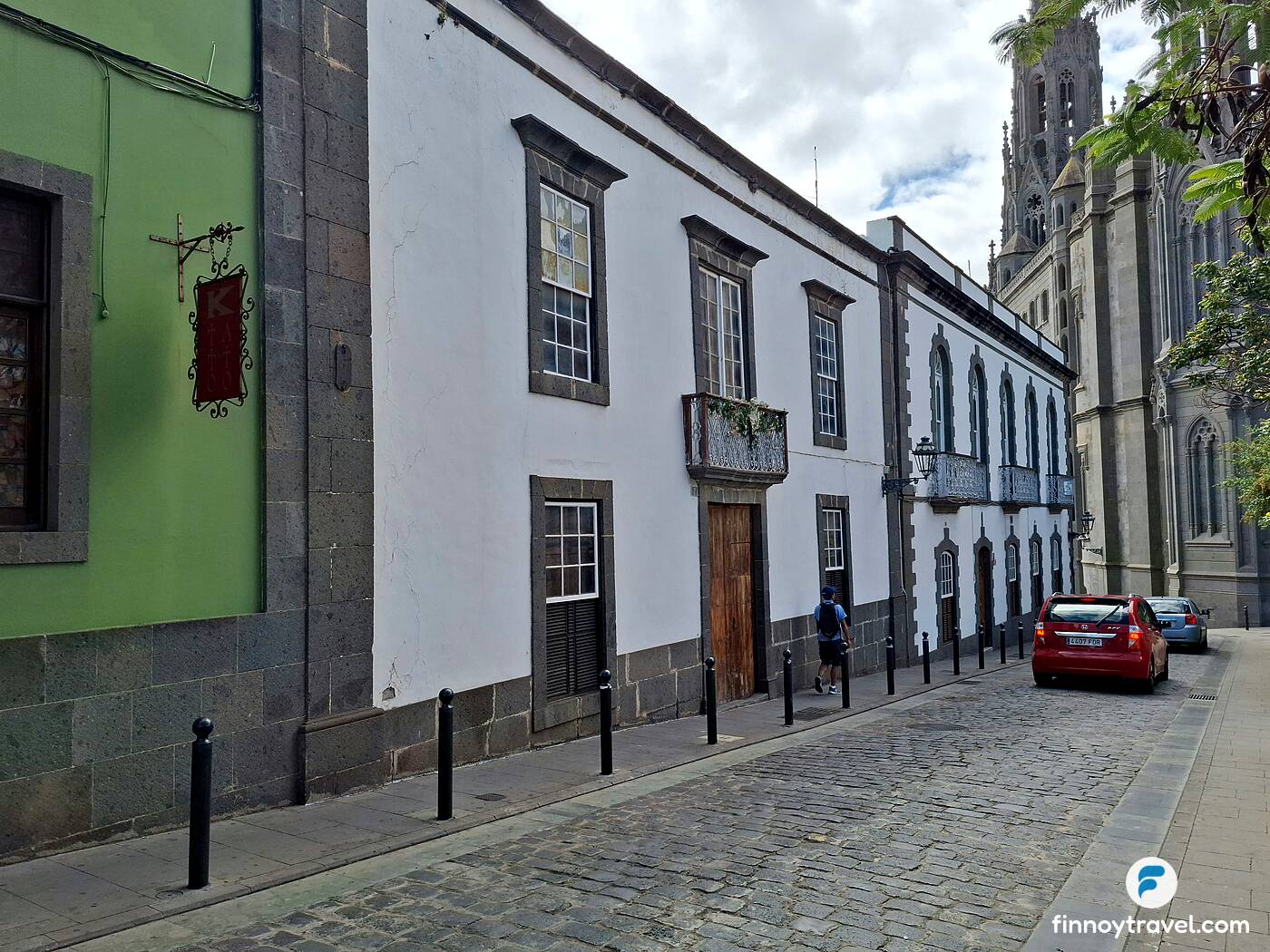
Los Azulejos
Nestled in the southwestern part of Gran Canaria, Los Azulejos is a geological marvel nicknamed "The Tile Fountain." This breathtaking landscape boasts vibrantly coloured rock formations from volcanic activity and time's artistry.
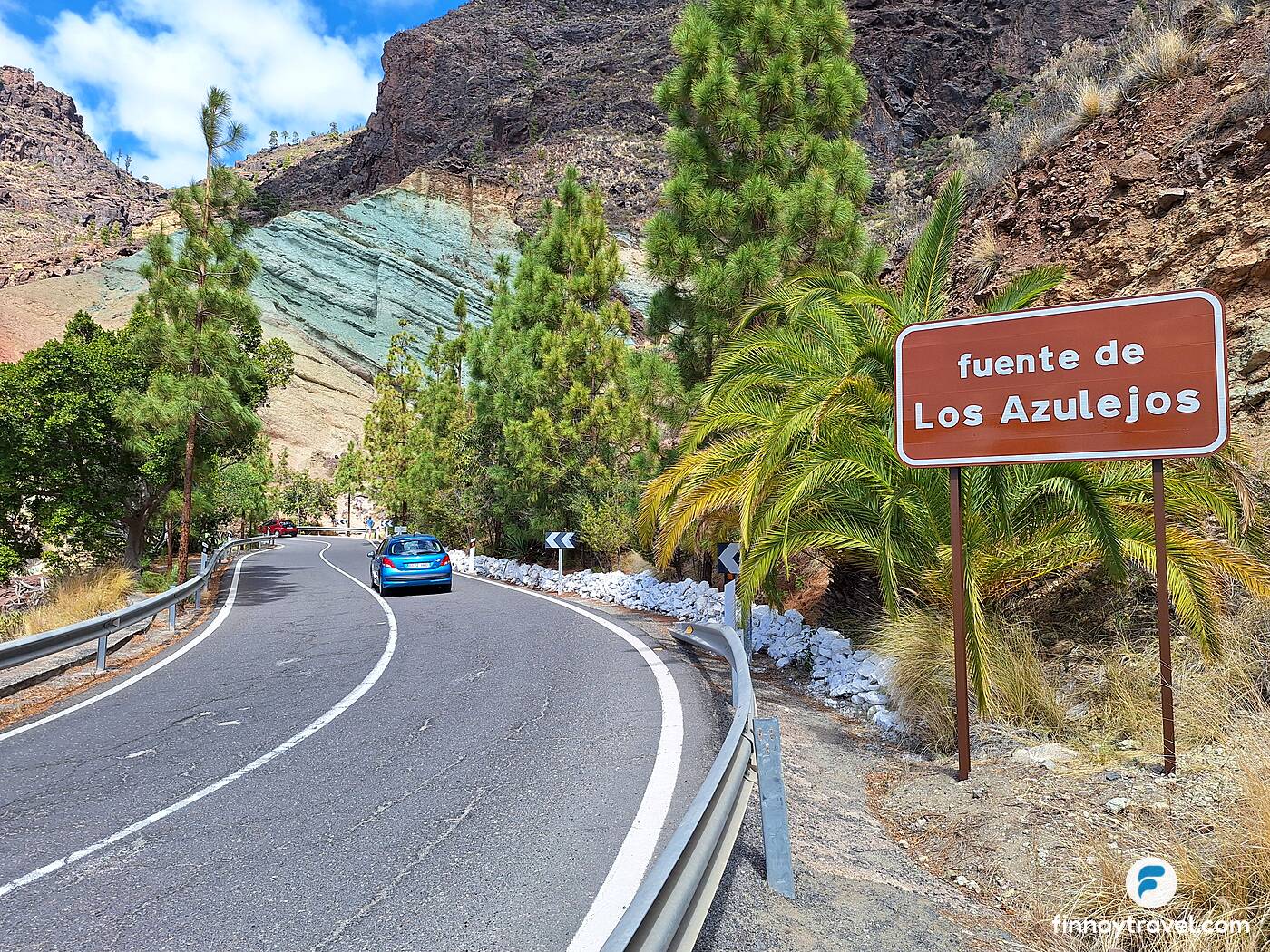
To reach Los Azulejos from the South, you'll embark on a scenic drive along the coast—Head towards Mogán and then westward on GC-200 towards La Aldea de San Nicolás. The colourful cliffs will soon appear, marking your arrival at Los Azulejos. The route is easy to drive, and the mountain roads are in good condition.
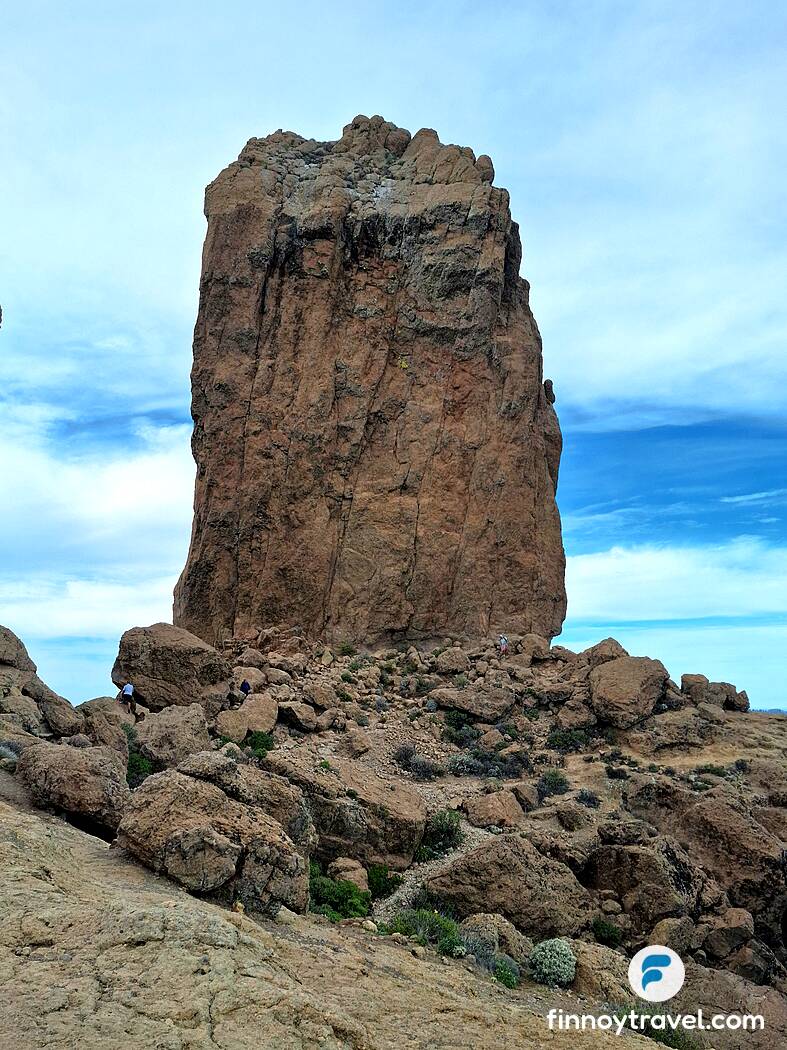
Dangers
Winding Roads and Sharp Bends
Gran Canaria's winding roads with sharp bends create many blind spots, making it difficult to see oncoming traffic. To navigate these safely, reduce your speed and stay within your lane, especially when approaching corners with limited visibility.
Distracted drivers
Be aware that many mountain drivers are likely unfamiliar with the roads. They might be distracted by navigating and enjoying the scenery, or they may not be accustomed to their rental car. Don't rely on other drivers' alertness. Always maintain a safe following distance to allow sudden braking due to unexpected manoeuvres.
Sudden Changes in Weather
Don't let mountain weather catch you off guard! Visibility can drop due to fog, rain, or strong winds. Be prepared to adapt your driving. If conditions worsen, pull over to a safe location and wait for things to clear. Headlights can pierce the fog, but remember to use low beams to avoid blinding oncoming drivers.
Falling Rocks
Watch out for falling rocks! Especially after heavy rain, loose rocks can become dislodged on the slopes. Always be alert for posted warnings and signs indicating potential rockfall zones. If you see falling rocks ahead, don't hesitate to pull over as far away from the danger zone as possible. Remember, falling rocks can damage your car – comprehensive insurance coverage is highly recommended for peace of mind while driving in mountainous areas.
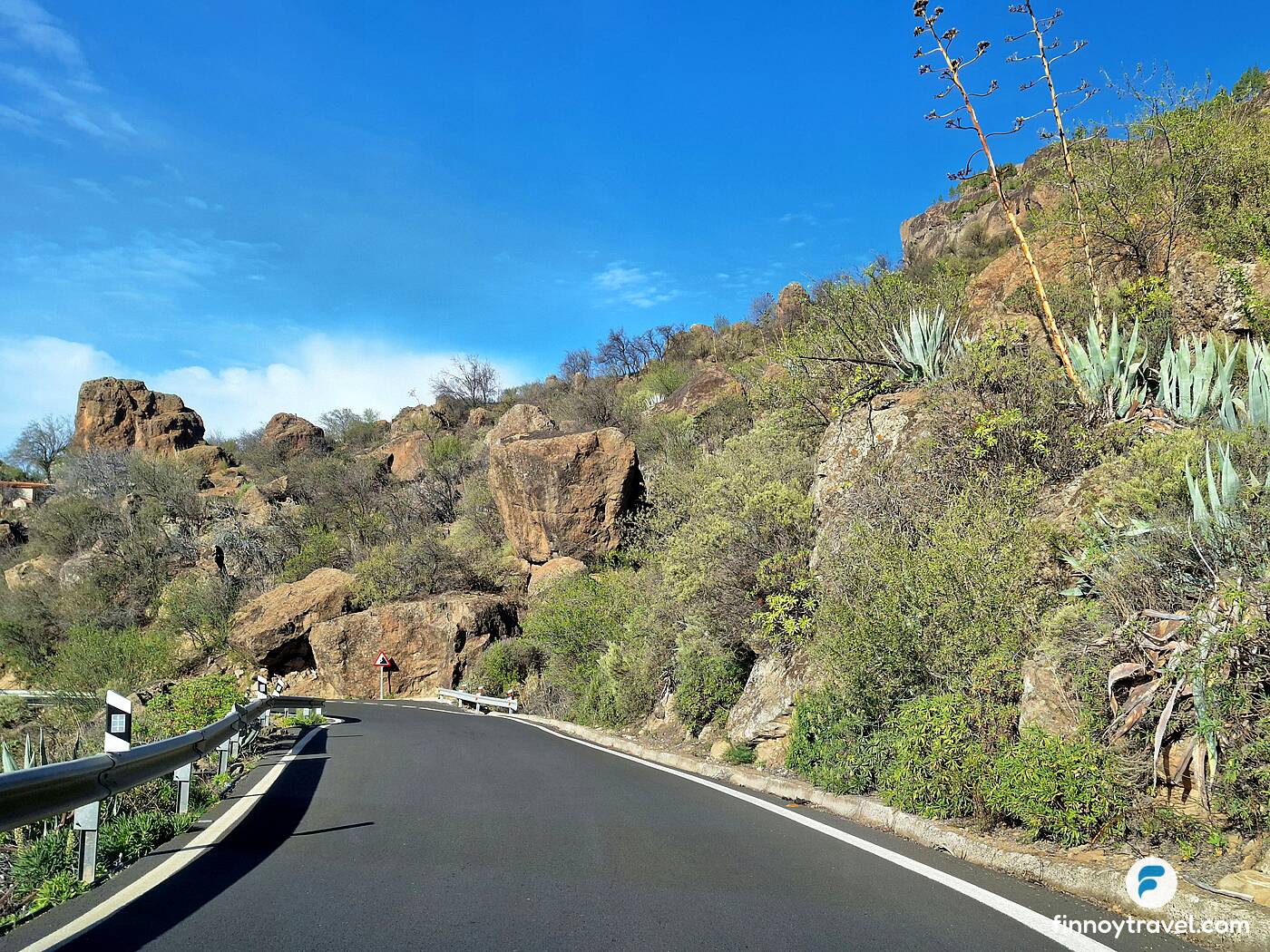
Bottom Line
We rented a car in Gran Canaria and explored the island for a week. Despite some bumps along the road with the rental company, having a car allowed us to discover hidden gems and enjoy the beautiful scenery.
While Gran Canaria isn't known for challenging driving overall, some key points must be remembered. Mountain roads require slower speeds due to blind spots, and village streets can be narrow with limited parking (consider garages!). So allow extra time for your journey along winding roads and narrow bends. Be prepared for occasional weather changes despite the island's usual sunshine.
Ever driven in Gran Canaria? Did you like it? Share your toughest challenges in the comments.



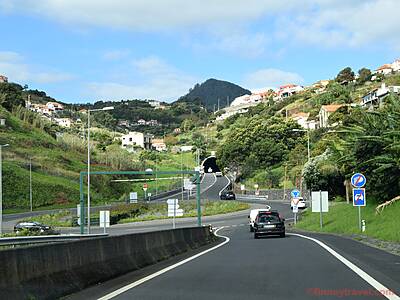
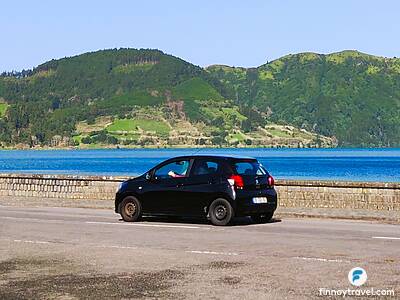

Add Comment
Comments